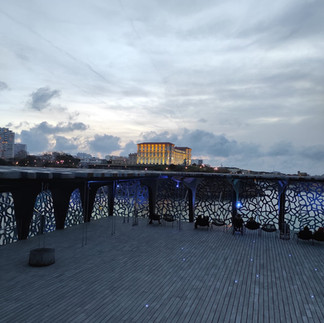The Panier - The Major - The Docks - The Mucem
- Simon LANDRY
.jpg/v1/fill/w_320,h_320/file.jpg)
- Jun 18, 2023
- 3 min read
Updated: Jul 30, 2023
Morning

The Panier district is the oldest in the city. When you walk inside, you have more the impression of being in a small village in Provence than in the center of Marseille. The alleys are flowery, paved and the facades are colored with tags, each one more beautiful than the other.
Many craft designer shops litter the streets, I bought some beautiful placemats from Madagascar at the store Le Panier d'épices. In the Les Navettes des Accoules shop, you will find the famous Navettes, traditional Marseille biscuits with orange blossom.
You can have lunch or have a drink on place de la Lenche, place Pistole or place des Treize-Cantons. If you want typical Marseille food, you have to go to Chez Etienne, in the mythical pizzeria du Panier founded in 1943 by Mr. Cassaro where you can eat the famous Marseille tomato anchovy pizza in the purest Neapolitan tradition, but also Provençal squid or lamb skewers garnished with rosemary.

In the heart of the Panier, a visit to the petanque museum is mandatory: the store la boule bleue recounts history petanque. There is even a very nice little indoor bowling alley to test Marseille sport. I myself have a petanque triplet from this store, just to be able to assert myself as a true Marseilles...
Another way to discover Le Panier is to admire the tags of local artists who share their passion for urban art on the walls of the neighborhood's Provençal streets.
For heritage lovers, I advise you to visit La Vieille Charité. Formerly built in the 17th century to shelter the poor and beggars, this monument is one of the most beautiful in Marseille. It now has a museum, a cultural and research center. The spaces on the ground floor present temporary exhibitions. The first floor houses the museum of Mediterranean archeology and the second the museum of African, Oceanian and Amerindian arts.


For the rest of this day, at the exit of the Panier, take the rue du Four du Chapitre which leads to the cathedral of La Major (photo below). Admission is free, you can admire the neo-Byzantine style of the 19th century, built by the architect Leon Vaudoyer.

For the lunch break, the Halles de The Major offer a wide choice of fresh Mediterranean products in a very friendly atmosphere. If you prefer to travel, the new restaurant Andia (opened March 2023) offers Andean cuisine in an Amazon jungle setting. Prices are a bit high but worth it. Another favorite is the Café Hippie Chic which offers fusion cuisine with original European and Asian dishes (photos below). Do not hesitate to look at my posts on the good addresses of Marseille to find out more.
Afternoon
Then head to the Docks, the symbol of the period of expansion and prosperity experienced by Marseille in the 19th century. Marseille being one of the first ports in the world, maritime activities had to be extended. These warehouses met these requirements. Today, atypical buildings attract tourists and architecture enthusiasts. The bars, restaurants and shops make it a lively place, appreciated by the people of Marseille. I particularly advise you to visit the boutique and the Mx bar, in homage to Paul Ricard.


In rainy weather, the Docks are a perfect place to have a drink with friends, play the board games provided by the Mx bar and play petanque on the indoor court. And even if the balls are foam, we still get into the game.
Once the visit to the Docks is over, I suggest you turn back to return to La Major.

In front of the cathedral, in front of the MUCEM, is the Cosquer Mediterranean Adventure. If you have time in your stay on another day, I advise you to take this tour which reconstructs the prehistoric Cosquer cave below sea level.
“I proposed to build a building that would welcome the sea, that would be open to it, that would be a gateway and not a barrier.” Stefano Boeri, architect of the Villa Méditerranée
Behind, the MUCEM, Musee des Cvilifications of Eeurope and the Mthe Mediterranean, was inaugurated in 2013 when Marseille was European Capital of Culture. It programs temporary exhibitions often linked to artistic or societal news.
The rooftop of the museum is magnificent, you can admire the view of the sea and the entrance to the old port. I advise you to go up there by the outdoor stairs, so as to see the landscape through the architecture of this concrete lace cube. You can take the 130 m footbridge connecting the MUCEM to Fort Saint Jean (see photo below), climb the King René tower to enjoy a sublime view of the old port and walk on the ramparts and in the courtyard of the Fort.


A second footbridge will take you back to the old port to end your walk.






























Comments